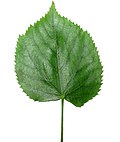Leaf
Leaf
A leaf is an organ of a vascular plant and is the principal lateral appendage of the stem.<ref>,
Anatomy of seed plants, Wiley, ISBN 978-0-471-24520-9,</ref> The leaves and stem together form the shoot.<ref>, Plant anatomy, Pergamon, ISBN 978-0-08-036983-8,</ref> Leaves are collectively referred to as foliage, as in "autumn foliage".<ref>
Foliage(link). {{{website}}}. Merriam-Webster Dictionary.
Accessed 2018-04-18.
</ref>
Structure[edit]
A typical leaf or phyllode has a broad expanded blade (also called the lamina), which is attached to the plant stem by a petiole.<ref>,
Anatomy of seed plants, Wiley, ISBN 978-0-471-24520-9,</ref>
Function[edit]
Leaves are the site where most photosynthesis takes place in plants.<ref>,
Plant Physiology and Development, Sinauer, ISBN 978-1-60535-255-8,</ref>
Types of leaves[edit]
There are many different types of leaves. They can be classified in many different ways, including by their shape, their edge, their pattern of venation, and by their arrangement on the stem.<ref>,
The Cambridge Illustrated Glossary of Botanical Terms, Cambridge University Press, ISBN 978-0-521-79401-5,</ref>
See also[edit]
References[edit]
<references />
External links[edit]
|
|
|
-
Leaf Varieties (15 sp)
-
Lisc lipy
-
Leaf, Bud, and Stem Diagram
-
Diagramed parts of leaves
-
3D rendering of a micro CT scan of a piece of dried leaf
-
Vein skeleton of a leaf (de-ghosted)
-
Leaf structure (labeled)
-
Eucalyptus foliage isobilateral dorsiventral
-
Travel Deep Inside a Leaf - Annotated Version - California Academy of Sciences
-
Rosa canina blatt
-
Citrus leaf
-
Fulles noves, magraner (partida de la Belenguera, Alginet, País Valencià)
Ad. Transform your life with W8MD's Budget GLP-1 injections from $75


W8MD offers a medical weight loss program to lose weight in Philadelphia. Our physician-supervised medical weight loss provides:
- Weight loss injections in NYC (generic and brand names):
- Zepbound / Mounjaro, Wegovy / Ozempic, Saxenda
- Most insurances accepted or discounted self-pay rates. We will obtain insurance prior authorizations if needed.
- Generic GLP1 weight loss injections from $75 for the starting dose.
- Also offer prescription weight loss medications including Phentermine, Qsymia, Diethylpropion, Contrave etc.
NYC weight loss doctor appointmentsNYC weight loss doctor appointments
Start your NYC weight loss journey today at our NYC medical weight loss and Philadelphia medical weight loss clinics.
- Call 718-946-5500 to lose weight in NYC or for medical weight loss in Philadelphia 215-676-2334.
- Tags:NYC medical weight loss, Philadelphia lose weight Zepbound NYC, Budget GLP1 weight loss injections, Wegovy Philadelphia, Wegovy NYC, Philadelphia medical weight loss, Brookly weight loss and Wegovy NYC
|
WikiMD's Wellness Encyclopedia |
| Let Food Be Thy Medicine Medicine Thy Food - Hippocrates |
Medical Disclaimer: WikiMD is not a substitute for professional medical advice. The information on WikiMD is provided as an information resource only, may be incorrect, outdated or misleading, and is not to be used or relied on for any diagnostic or treatment purposes. Please consult your health care provider before making any healthcare decisions or for guidance about a specific medical condition. WikiMD expressly disclaims responsibility, and shall have no liability, for any damages, loss, injury, or liability whatsoever suffered as a result of your reliance on the information contained in this site. By visiting this site you agree to the foregoing terms and conditions, which may from time to time be changed or supplemented by WikiMD. If you do not agree to the foregoing terms and conditions, you should not enter or use this site. See full disclaimer.
Credits:Most images are courtesy of Wikimedia commons, and templates, categories Wikipedia, licensed under CC BY SA or similar.
Translate this page: - East Asian
中文,
日本,
한국어,
South Asian
हिन्दी,
தமிழ்,
తెలుగు,
Urdu,
ಕನ್ನಡ,
Southeast Asian
Indonesian,
Vietnamese,
Thai,
မြန်မာဘာသာ,
বাংলা
European
español,
Deutsch,
français,
Greek,
português do Brasil,
polski,
română,
русский,
Nederlands,
norsk,
svenska,
suomi,
Italian
Middle Eastern & African
عربى,
Turkish,
Persian,
Hebrew,
Afrikaans,
isiZulu,
Kiswahili,
Other
Bulgarian,
Hungarian,
Czech,
Swedish,
മലയാളം,
मराठी,
ਪੰਜਾਬੀ,
ગુજરાતી,
Portuguese,
Ukrainian












